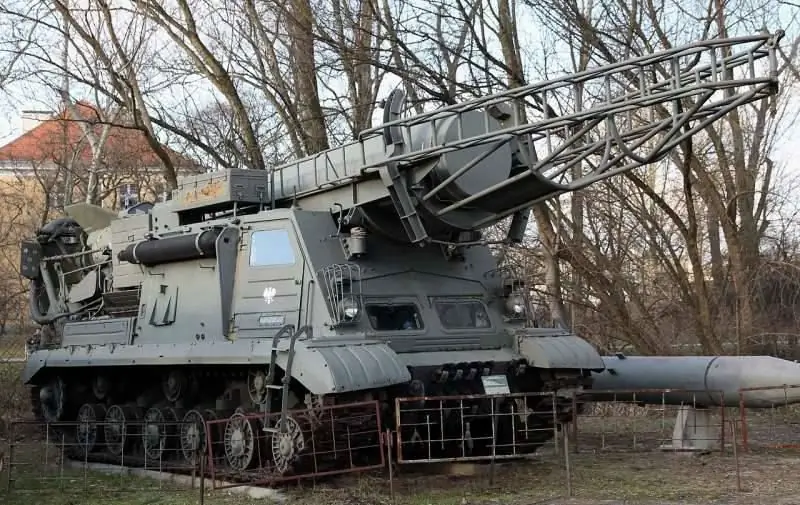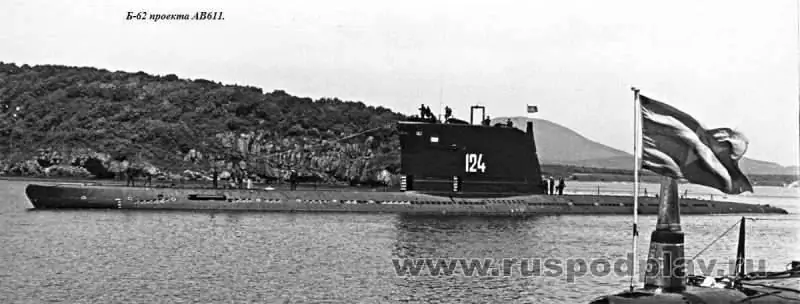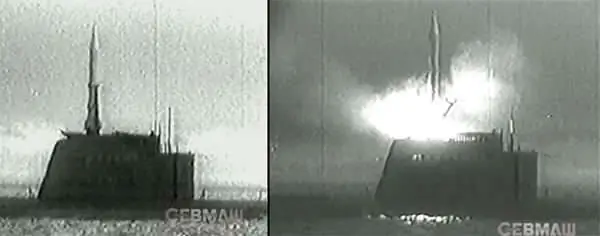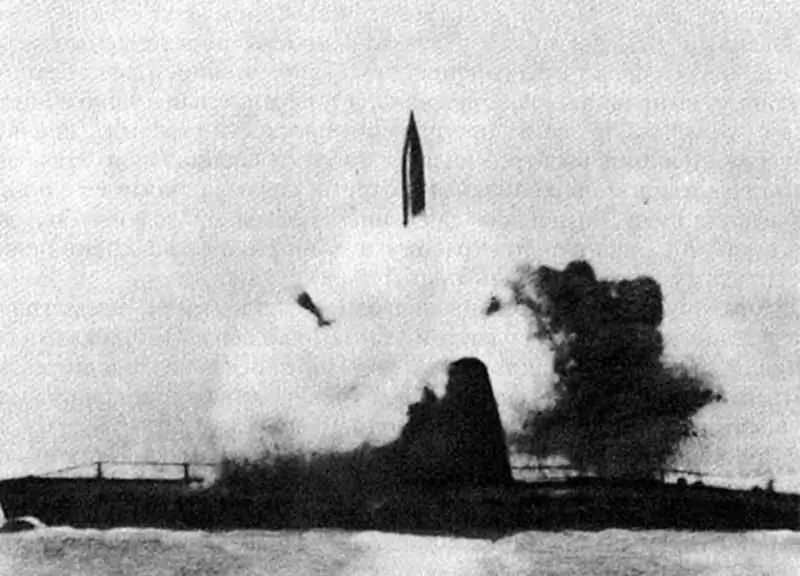- Author Matthew Elmers [email protected].
- Public 2023-12-16 21:49.
- Last modified 2025-01-24 09:17.
The project of a promising P-2 submarine with jet armament was stopped at the earliest stages due to the excessive complexity and the impossibility of its implementation based on the technologies of the late forties. Nevertheless, work in the promising direction was continued, since the fleet continued to show great interest in missile weapons for submarines. The result of continued research and design work was the adoption of the D-1 missile system with the R-11FM missile. It was the first in our country and in the world a ballistic missile system designed for installation on submarines. In addition, the R-11FM remained in history as the first ballistic missile that was successfully launched from a submarine.
In January 1954, specialists from the Soviet defense industry held several meetings, during which further plans for the development of new weapons and equipment for the Navy were determined. By this time, a number of important projects had been implemented, which made it possible to come to grips with the creation of promising submarines with ballistic missiles. On January 26, a resolution of the Council of Ministers was issued, in accordance with which it was required to develop a complex of missile weapons for installation on submarines.
During the first few months, the aim of the work was to assess the existing opportunities and determine the prospects for the project. This stage made it possible to determine the basic requirements for new technology, as well as to shape the appearance of a new missile system with ballistic missiles. In addition, some design work was carried out to change existing products, which were planned to be used as the basis for new weapons. In August 1955, the requirements for the new project were formulated and approved by the customer.

Launch of the R-11FM rocket from the Project 629 submarine. Photo Ruspodplav.ru
The first domestic ballistic missile for submarines was to be the R-11FM product. As a basis for this weapon, it was proposed to take the R-11 rocket, a little earlier adopted by the ground forces. This made it possible to accelerate the development of a new rocket system, as well as to a certain extent simplify serial production and operation. The missile system for submarines based on the R-11FM missile was named D-1. Its development was entrusted to NII-88, headed by S. P. Korolev. It should be noted that the rocket for the new complex was selected even before the final requirements were approved. Moreover, by this time the specialists had completed a number of basic works.
To use the "land" missile as a weapon for submarines, it was necessary to modify its design, as well as to create some new components and assemblies. In particular, it was necessary to ensure the normal operation of missiles in sea conditions, as well as develop new launch systems with appropriate characteristics. Due to the main features of the intended operation, the modifications of the rocket were relatively simple: it was only necessary to seal the hull to avoid water ingress and make some other adjustments. With regard to launch devices, in this case, a large number of new systems had to be developed from scratch.
The R-11FM product, which was a modified version of the basic R-11, was a single-stage liquid-propellant ballistic missile. All units were located inside a cylindrical body with a pointed head fairing and an X-shaped tail assembly. The separation of the rocket in flight was not provided, the warhead was not separated. The entire trajectory of the product had to pass in the form of a single unit.
R-11FM retained the layout of its predecessors, typical for ballistic missiles of that time. The head part of the product contained a warhead, the central part was given under the tanks for fuel and oxidizer, and the instrument compartment and the engine were located in the tail. To facilitate the construction, load-bearing fuel tanks with a wall thickness of up to 3-3.5 mm were used. In the tail section of the hull there were trapezoidal stabilizers on which graphite gas-dynamic rudders were mounted.

R-11 surface-to-ground missile on a transport trolley. Photo Militaryrussia.ru
The rocket for the fleet received a liquid engine of the C2.235A type, running on kerosene and nitric acid. For launch, according to some sources, a mixture of TG-02 was used. Consuming 7.9 kg of fuel and 30 kg of oxidizer per second, the engine could develop thrust up to 8.3 tons (on the ground). The maximum run time was 90 s, but in practice the run time depended on the flight program.
The missile control system was based on gyroscopic systems. The gyroscopic integrator of longitudinal accelerations L22-5, gyro-vertical L00-3F and gyrohorizont L11-3F were used. The task of this equipment was to track changes in the course of the rocket and issue commands to the steering cars. Like other ballistic missiles of that time, the R-11FM had to be guided by turning the launch pad in the desired direction and by entering the necessary data into the automation. After the start, the autopilot and gyroscopes had to maintain the required trajectory, and also turn off the engine at the right time. After that, the rocket was supposed to go into uncontrolled flight along a ballistic trajectory.
It was proposed to destroy the target using a special warhead in the form of an RDS-4 charge with a capacity of 10 kt. In addition, according to some reports, a high-explosive warhead could be used. The payload of the R-11FM rocket could reach 1000 kg, but some of the proposed warheads had less weight.
The R-11FM rocket had a length of 10.4 m and a body diameter of 0.88 m. The scope of the stabilizer was 1818 mm. The launch mass of the product did not exceed 5350 kg, of which less than 1350 kg accounted for the design and equipment of the rocket. The tanks held up to 3700 kg of fuel and oxidizer.

Launcher of the R-11 complex. Photo Wikimedia Commons
By changing the parameters of the trajectory, achieved by correcting the course and reducing the engine operation time, the rocket of the new type could fly at a range of 46 to 150 km. Some sources mention the possibility of shooting at 160-166 km. The circular probable deviation when firing at the maximum range, according to the requirements for the project, should not have exceeded 3 km. Further improvement of guidance systems made it possible to significantly improve the accuracy of serial missiles.
To use the new R-11FM ballistic missile, the D-1 launch complex was developed. A set of special equipment was to be installed on the carrier submarine, responsible for storing and launching the rocket. Systems of the D-1 complex, including with some modifications, were used in several projects of promising submarines.
It was proposed to store the missile in special vertical shafts inside the submarine's hull. The mine was supposed to be a sealed container to ensure safe immersion. In addition to the rocket in the mine, it was proposed to place an SM-60 launch pad with a set of mounts for the product, as well as a lifting device. Due to the lack of the necessary technologies, it was proposed to launch the R-11FM rocket in the surface position of the carrier from the launch pad raised to the end of the shaft. It was proposed to bring the table with the rocket into the working position using a special lifting system based on cables.
When preparing the submarine for going to sea, it was proposed to fill the rocket with fuel and an oxidizer. In a fueled state, the R-11FM missiles could be stored for three months - until the completion of the combat patrol of the carrier. The absence of the need for refueling before launch made it possible to significantly speed up the process of preparing the rocket for firing in comparison with previous developments in this area.

Submarine of project B-611. Figure Shirokorad A. B. "Weapons of the Russian Navy. 1945-2000"
Together with the launching systems, the carrier submarine was supposed to receive the Dolomit ship calculating device. His task was to calculate and introduce the flight program into the automation of the rocket. In addition, this device included the so-called. rolling warning. This subsystem was supposed to track the position of the submarine in space and determine the optimal moment for issuing a command to start the rocket engine. It was assumed that the rocket will be launched at the lowest possible deviation from the vertical.
The number of missiles on a submarine depended on the type of the latter. Different projects of submarine carriers of the D-1 complex involved the installation of a different number of silos for transporting missiles and other special equipment. In addition, submarines of different types could differ from each other in the composition of additional equipment. Due to the relatively large dimensions of the missiles and the small size of submarines, the ammunition load of serial submarines of new types did not exceed three missiles.
In the spring of 1955, it was decided to transfer the development of a new project to another organization. NII-88 / OKB-1 now had to deal with other systems, and the project of the D-1 complex with the R-11FM rocket was transferred to the SKB-385 (now the State Missile Center). The new project manager was V. P. Makeev. The Makeyev Design Bureau completed the development of a new missile system, and later created a large number of new systems for a similar purpose.
At about the same time, the R-11FM project reached the stage of field tests. The Kapustin Yar test site has become a platform for testing the updated rocket. According to reports, the first launches were carried out from a stationary launcher. Subsequently, a swinging stand of the CM-49 type was used in the tests. This device simulated the pitching of the carrier submarine and made it possible to test various means of the complex, including the rolling warning. The applied ideas and solutions paid off: the rocket took off without any problems and malfunctions even from the swinging stand.

Submarine B-62, project AV-611. Photo Ruspodplav.ru
Since 1953, the development of a promising submarine was carried out, which was supposed to become the first carrier of the D-1 missile system. The design of this submarine was entrusted to TsKB-16 (now SPMBM "Malakhit"), the work was supervised by N. N. Isanin. The base for the submarine with missile weapons was the project "611". The new project was designated B-611. The new project differed from the basic version by the removal of a number of components and assemblies, instead of which it was proposed to install new elements of the missile system.
A diesel-electric submarine B-67 of project 611, which was accepted into the fleet in 1953, was allocated for use as an experimental missile carrier. During the modernization, which began in 1955, the submarine lost all the equipment of the fourth compartment. All devices were dismantled from the bottom of the solid hull to the solid cabin. Structures separating the decks were also removed. In the freed volume, both in the hull and in the wheelhouse, new systems for transporting and launching missiles were installed. The submarine received two missile silos with a height of 14 m and a diameter of about 2 m. Launch tables with mechanisms for lifting to an operating position were placed inside the shafts. In addition, various systems were provided for securing the rocket in the transport position, preventing its movement.
The capabilities of the modernized submarine B-67 made it possible to fire on the surface when the sea is rough up to 5 points at speeds up to 10-12 knots. To prepare for launch, the crew of the submarine required a number of special procedures that took about two hours. In this case, the submarine could remain at depth. Immediately before launch, it was necessary to surface and complete preparations. The shaft lid was opened, and the launch pad with the rocket was lifted. The first launch could be performed 5 minutes after surfacing. It also took 5 minutes to launch the second rocket.
On September 15, 1955, the B-67 submarine was for the first time in the world armed with a ballistic missile. In the strictest secrecy at one of the bases of the Northern Fleet, new weapons were loaded into the mines of the submarine. Soon the submarine went to sea. On September 16, at 17:32 local time, the world's first ballistic missile launch from a submarine took place in the White Sea. Until the end of the year, seven more launches were carried out as part of the first stage of testing.

Project 629 submarine. Drawing by Wikimedia Commons
The following year, tests were carried out, the purpose of which was to test the missile system in a real campaign. For several weeks, the B-67 submarine was on the patrol route and checked the performance of all new systems. According to some reports, during this campaign, rocket firing was carried out.
Tests of R-11FM missiles on the B-67 submarine continued until 1958. During this time, several dozen missile launches were carried out, most of which ended in successful defeat of conventional targets. The tests reportedly showed improved accuracy characteristics. The KVO of the rocket in practice was significantly lower than the calculated one. In 65% of launches, the deviation did not exceed 1050 m - almost three times better than the required specification.
According to the test results in February 1959, a decree was issued on the adoption of the D-1 complex with the R-11FM rocket for service with the Soviet Navy. By this time, the Navy had only one submarine capable of carrying new missiles - the B-67 of the B-611 project. However, measures have already been taken to significantly increase the ballistic missile submarine force.
By the end of the decade, on the basis of existing developments, a new version of the project of a diesel-electric submarine with the designation "AV-611" was created, which was a further development of the B-611 project. In accordance with this project, at the end of the fifties, the experienced B-67 was modernized. In addition, submarines B-62, B-73, B-78, B-79 and B-89 were soon converted according to the AV-611 project. Like the B-67, they carried two R-11FM missiles.

The first launch of the R-11FM rocket from the B-67 submarine, September 16, 1955. Photo Defendingrussia.ru
Since 1956, TsKB-16 has been developing project 629. Its goal was to create a diesel-electric submarine capable of carrying new types of missiles. Until a certain time, the project was created taking into account the use of only the D-1 complex. In the future, there was a proposal to introduce some features into the design of boats that would allow them to be modernized using the promising D-2 complex. Thus, in the distant future, new submarines were able to change their main weapons without much difficulty.
Project 629 involved equipping the submarine with three silos for missiles and related equipment. Relatively long blocks of mines were placed inside a solid hull and deckhouse. In addition, there was a characteristic bottom protrusion. Due to some design improvement in comparison with existing projects, boats of the "629" type had better characteristics in terms of launching missiles. So, the possibility of shooting in waves of up to 5 points was preserved, and the maximum speed during launch increased to 15 knots. Submerged prelaunch preparation took only an hour. It took 4 minutes to launch the rocket after surfacing. A full salvo took 12 minutes, after which the submarine could go to depth.
The lead submarine of Project 629, B-92, was laid down in the fall of 1957. The fleet received it at the very end of 1959. Until the end of 1962, 23 submarines of a new type were built and handed over to the customer. All of them were distributed among the main operational-strategic formations of the USSR Navy.
The construction of new submarines allowed the Soviet Union to deploy a full-fledged group of submarine forces with ballistic missiles. With some reservations, the boats of projects AV-611 and 629 can be considered the first domestic missile submarine strategic cruisers. Despite the relatively short flight range of 150 km, the R-11FM rocket was able to hit various important ground targets on the territory of a potential enemy using nuclear warheads.

Rocket launch. Photo Defendingrussia.ru
Operation of 29 submarines with the D-1 missile system continued until 1967. During this time, the crews performed 77 launches, 59 firing was recognized as successful. At the same time, only three launches ended in an accident due to technical reasons. Seven more fell through due to personnel errors, including in determining the coordinates of the submarine, and the reasons for eight were never determined.
The D-1 complex with the R-11FM rocket was decommissioned in 1967. The reason for the abandonment of these systems was the emergence of new weapons with higher characteristics. First of all, the replacement of existing complexes was carried out using D-2 systems with R-13 missiles. So, project 629 submarines were initially developed taking into account possible rearmament, and in the mid-sixties such plans were implemented. Over the next few years, the former carriers of the R-11FM missiles used weapons of the new model.
The result of the D-1 / R-11FM project was the appearance of the first in our country and in the world a ballistic missile suitable for use on submarines. In terms of basic characteristics (for example, in terms of range, which did not exceed 150-160 km), the R-11FM was inferior to similar ground-based systems, however, even with the available parameters, it was a fairly powerful weapon. The carrier submarine could covertly pass into a given area and deliver a nuclear missile strike at a coastal target at a considerable distance. The appearance of such submarines significantly increased the strike potential of the fleet, and also made it an element of the strategic nuclear forces.
By modern standards, the D-1 missile system did not have high performance. Nevertheless, for its time it was a real breakthrough in the field of naval weapons. The project of the D-1 complex with the R-11FM missile not only proved the fundamental possibility of equipping submarines with ballistic missiles, but also led to the rearmament of the submarine forces. The D-1 / R-11FM project was the first representative of its class and launched numerous new developments that are still used to ensure the country's strategic security.






